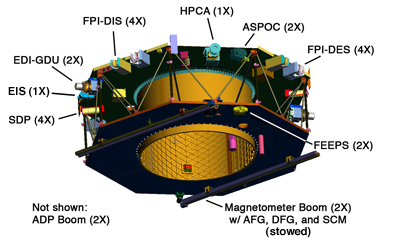Payload (IV)
Instrument Descriptions (cont'd)

III. FIELDS: The FIELDS investigation is an advanced suite of six sensors to measure critical electric and magnetic fields in and around reconnection regions. The investigation is led by Co-I R. B. Torbert (University of New Hampshire).
- Analog Fluxgate (AFG) and Digital Fluxgate (DFG) Magnetometers: The AFG and DFG sensors are provided by UCLA and the Technical University of Braunschweig, respectively. C. T. Russell (UCLA) has overall responsibility for fluxgate development. The two different kinds of magnetometers will provide redundant measurements of the magnetic field and current structure in the diffusion region.
- Electron Drift Instrument (EDI): The EDI determines the electric and magnetic fields by measuring the drift of ~1 keV electrons emitted from the Gun Detector Unit (GDU). Each GDU sends (receives) a coded beam to (from) the other EDI-GDU. The EDI gun is being developed at the Institut fuer Weltraumforschung of the Austrian Academy of Sciences; EDI optics are being developed at the University of Iowa.
- Double Probes: MMS requires two sets of double-probe instruments. The Spin-plane Double Probe (SDP) consists of four 48-meter wire booms with spherical sensors at the end. The Axial Double Probe (ADP) consists of two 10-meter antennas deployed axially near the spacecraft spin axis. The SDP and ADP provide full 3D electric field measurements over a range from DC to 100 kHz with an accuracy of 0.5 mV/m (SDP) and 1 mV/m (ADP). The double-probe instruments were developed by the following institutions: the Swedish Institute of Space Physics, the Swedish Royal Institute of Technology, the University of Colorado, and the University of New Hampshire.
- Search Coil Magnetometer (SCM): The SCM will measure the 3-axis AC magnetic field up to 6 kHz and will be used together with the ADP and SDP to determine the contribution of plasma waves to the turbulent dissipation that occurs in the diffusion region. The SCM is being developed in France at the Centre d'etude des Environnements Terrestre et Planetaires.
|